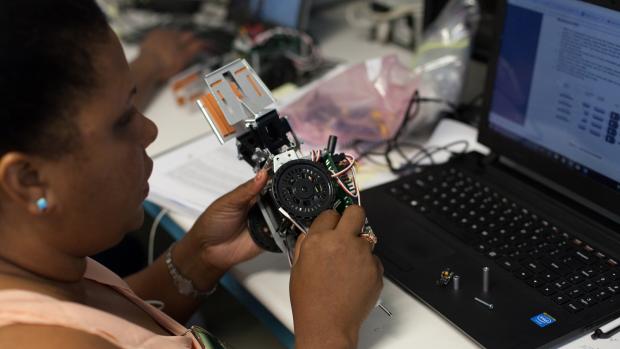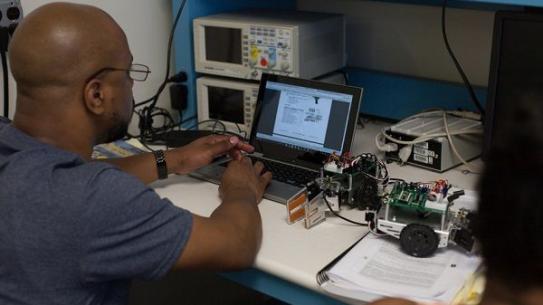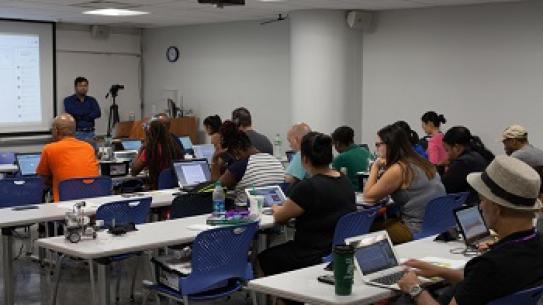Summer Programs Train Teachers in Engineering and Robotics

Middle school science teacher Sherrlyne Gilles embarked on a summer of robotics through the RET program at NYU Tandon.
“I always want to expose my students to the latest innovations in STEM, and the only way I can keep them abreast of what’s going on is if I know it myself,” Sherrlyne Gilles said. As a teacher at Mott Hall IV middle school junior high in Brooklyn, Gilles teaches General Science and Living Environment, educating her students on the functions of organisms and the basics of biology. This summer, however, she spent her time tinkering with a Parallax robot and assisting doctoral researchers in the Applied Micro-bioengineering Laboratory at NYU Tandon.
Gilles, along with eight other teachers from New York City schools, joined Tandon’s Research Experience for Teachers (RET) program, also known as RET Site in Mechatronics and Robotics with Entrepreneurship and Industry Experiences — a National Science Foundation-sponsored initiative that has been educating educators since 2003. With robotics becoming increasingly integral to STEM curricula, many teachers are seeking ways for both themselves and their students to learn about new opportunities within science, technology, engineering, and mathematics.
RET is one of three summer programs at NYU Tandon geared towards New York educators hoping to build their expertise in robotics, mechatronics, and entrepreneurship. (The others are Discovery Research, also known as DR K-12, and the new Innovative Technology Experiences for Students and Teachers, or ITEST.)
During the six-week program, RET participants work in pairs based upon similar interests to build their knowledge and skills in mechatronics and robotics and conduct research within one of NYU Tandon’s laboratories. With its focus on entrepreneurship, RET also offers training and workshops with important industry partners: this summer, teachers spent two days learning robotics with BlocklyProp from Parallax, Inc., a California-based company, and visited such firms as Honeybee Robotics and VirtualApt Corp, as well as the start-ups at Tandon’s Data Future Lab.
Professor of Mechanical and Aerospace Engineering Vikram Kapila, who leads the RET and DR K-12 programs at NYU Tandon, detailed the unique environment in the school’s labs during the summer months. “With these programs, teachers, high school students in our ARISE (Applied Research Innovations in Science and Engineering) program, graduate and undergraduate students, and NYU Tandon professors are all working together in the lab. It’s an ecosystem in which learning takes place,” Kapila said.
Within Professor of Mechanical and Aerospace Engineering Weiqiang Chen’s lab, Gilles and her RET partner, Scott Carlson, used sophisticated MATLAB software to process images that detect forces across cell membranes. The pair also developed lesson plans that introduce students to coding and lab practices. While some topics may be new to the RET participants, Carlson — a chemistry teacher at W.H. Maxwell Career and Technical Education High School in Brooklyn — was up for the challenge.

“I’ve never done any of these things before, so it’s been a lot of trial by fire,” Carlson admitted. “It’s also a lot of fun to have the freedom to explore and experiment, which is one of the most valuable parts of the program. Without that autonomy, we wouldn’t necessarily have a chance to explore what could have gone right, wrong, or different, the way a student would. We’re discovering ways to really reach our kids with this.”
Both teachers hope to start robotics programs at their respective schools, with the ultimate goal of having competing robotics teams. Carlson already has a few interested students ready to take on robotics, and, because Tandon graduate students visit the schools several times during the year to help teachers implement the plans made during RET, he hopes that continued support will encourage his students to explore the unlimited possibilities within STEM. He asserts, “Every season, I will plan for our robotics team to ramp up what they know and can create, and eventually the students will be able to say they work with Arduino, Pbasic, or C++ programming. I want them to have those skills and say to their potential future employers, ‘Look at all the things I can do.’”
Teachers discover robotics for themselves and their students
Inspiring young innovators, inventors, and engineers is at the heart of the Discovery Research (DR K-12) program at NYU Tandon. Aimed at engaging with and educating middle school teachers, the program calls upon them to collaborate with NYU Tandon doctoral students in creating curricula, programs, and lessons that will introduce their young students to robotics and start them on their STEM careers.
This summer, Jane Lam of Sunset Park Prep M.S. 821 and Joe Macchia of the Urban Science Academy in the Bronx, two teachers who had joined the program last year, returned as mentors to guide the new participants through difficult subjects, while also gleaning more insights into coding and programming themselves.
“I returned this year to get a deeper understanding of the programming required to extend the robot's utility to the more specific requirements of my students,” Macchia said. (Studying STEM at Tandon was a Macchia family affair last summer; his daughter was an eager participant in the school’s Science of Smart Cities program.) After participating in DR K-12 for the first time, Macchia had been gratified to see his students’ excitement at using simple code to animate a robot. “Once my students understand the power of being able to make the robot do what they want it to do, I can begin to lead them during a class or afterschool program to a place where they can select problems or challenges and develop solutions using the robots.”

Lam shared her appreciation of the program’s year-round involvement with the teachers. “At first, I was nervous about implementing robotics into my class,” she said, “but the program and support provided after the initial professional development was extremely helpful when I brought the robots back to the classroom.” Now, with the guidance of her NYU Tandon graduate student mentor, she plans to train her students to run coding software and develop coding language skills.
“Not only are these programs benefitting the K-12 teachers and students, but also the graduate and undergraduate students working with DR K-12, RET, and ITEST,” Kapila said. “It’s broadening their perspectives on how science, engineering, mechatronics, and robotics can benefit society. They’re learning to translate their education into education for others.”
Faculty and staff from NYU Tandon and NYU Steinhardt serve as co-principle investigators and members of the RET and DR K-12 programs. RET includes Kapila, Chen, Joo Kim, Oded Nov, Maurizio Porfiri, and Ben Esner. DR K-12 includes Kapila, Magued Iskander, Catherine Milne, Jasmine Y. Ma, and Esner.
Camila Ryder
Graduate School of Arts and Science
Master of Arts in English Literature, Class of 2018




